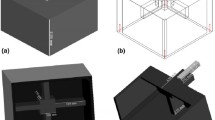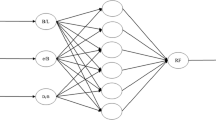Abstract
In the recent past years, utilization of intelligent models for solving geotechnical problems has received considerable attention. This paper highlights the feasibility of adaptive neuro-fuzzy inference system (ANFIS) for predicting the bearing capacity of thin-walled foundations. For this reason, a data set comprising nearly 150 recorded cases of footing load tests was compiled from literature. Footing width, wall length-to-footing width ratio, internal friction angle, and unit weight of soil were set as inputs of the predictive model of bearing capacity. In addition, a pre-developed artificial neural network (ANN) model was utilized to estimate the bearing capacity of thin-walled foundations. The results recommend the workability of ANFIS in predicting the bearing capacity of thin-walled foundation. The coefficient of determination (R 2) results of 0.933 and 0.875, and root mean square error (RMSE) results of 0.075 and 0.048 for training and testing data sets show higher accuracy and efficiency level of ANFIS in estimating bearing capacity of thin-walled spread foundations compared to the ANN model (R 2 = 0.710, RMSE = 0.512 for train, R 2 = 0.420, RMSE = 0.529 for test). Overall, findings of the study suggest utilization of ANFIS, as a feasible and quick tool, for predicting the bearing capacity of thin-walled spread foundations, though further study is still recommended to enhance the reliability of the proposed model.








Similar content being viewed by others
References
Rezaei H, Nazir R, Momeni E (2016) Bearing capacity of thin-walled shallow foundations: an experimental and artificial intelligence-based study. J Zhejiang Univ Sci A 17(4):273–285
Al-Aghbari MY, Mohamedzein YA (2004) Model testing of strip footings with structural skirts. Proc ICE Ground Improv 8(4):171–177. https://doi.org/10.1680/grim.2004.8.4.171
Eid HT, Alansari OA, Odeh AM et al (2009) Comparative study on the behavior of square foundations resting on confined sand. Can Geotech J 46(4):438–453
Al-Aghbari MY, Dutta RK (2008) Performance of square footing with structural skirt resting on sand. Geomech Geoeng 3(4):271–277. https://doi.org/10.1080/17486020802509393
Mana DS, Gourvenec S, Martin CM (2012) Critical skirt spacing for shallow foundations under general loading. J Geotech Geoenviron Eng 139(9):1554–1566
Nazir R, Momeni E, Marsono K et al (2013) Precast spread foundation in industrialized building system. In: Proceedings of the 3rd International Conference on Geotechnique, Construction Materials and Environment, Nagoya, Japan, p. 13–15
Nazir R, Momeni E, Marsono K et al (2015) Prediction of bearing capacity of thin-walled spread foundation using ICA-ANN predictive model. In: Proceedings of the International Conference on civil, structural and transportation engineering, Ottawa, Ontario- May 4th, Paper No. 319
Eid HT (2013) Bearing capacity and settlement of skirted shallow foundations on sand. Int J Geomech 13(5):645–652. http://doi.org/10.1061/(ASCE)GM.1943-5622.0000237
Wakil AZE (2010) Horizontal capacity of skirted circular shallow footings on sand. Alex Eng J 49(4):379–385
Wakil AZE (2013) Bearing capacity of skirt circular footing on sand. Alex Eng J 52(3):359364
Momeni E, Nazir R, Jahed Armaghani D et al (2015) Bearing capacity of precast thin-walled foundation in sand. Geotech Eng 168(6):539–550
Saleh NM, Alsaied AE, Elleboudy AM (2008) Performance of skirted strip footing subjected to eccentric inclined load. Electron J Geotech Eng 13(F):1–33
Fattah MY, Shlash KT, Mohammed HA (2014) Bearing capacity of rectangular footing on sandy soil bounded by a wall. Arab J Sci Eng 39(11):7621–7633
Shahin MA (2015) A review of artificial intelligence applications in shallow foundations. Int J Geotech Eng 9(1):49–60
Momeni E, Nazir R, Jahed Armaghani D et al (2014) Prediction of pile bearing capacity using a hybrid genetic algorithm-based ANN. Measurement 57:122–131
Momeni E, Nazir R, Jahed Armaghani D et al (2015) Application of artificial neural network for predicting shaft and tip resistance of concrete piles. Earth Sci Res J 19(1):85–93. http://doi.org/10.15446/esrj.v19n1.38712http://doi.org/10.15446/esrj.v19n1.38712
Padmini D, Ilamparuthi K, Sudheer K (2008) Ultimate bearing capacity prediction of shallow foundations on cohesionless soils using neurofuzzy models. Comput Geotech 35(1):33–46
Jahed Armaghani D, Tonnizam Mohamad E, Momeni E et al (2014) An adaptive neuro-fuzzy inference system for predicting unconfined compressive strength and Young’s modulus: a study on Main Range Granite. Bull Eng Geol Environ 74(4):1301–1319
Simpson PK (1990) Artificial neural system: foundation, paradigms, applications and implementations. Pergamon, New York
Shahin MA, Maier HR, Jaksa MB (2002) Predicting settlement of shallow foundations using neural networks. J Geotech Geoenviron Eng 128(9):785–793
Haykin S (1999) Neural Networks, 2nd edn. Englewood Cliffs, Prentice-Hall
Rezaei M, Monjezi M, Moghaddam SG, Farzaneh F (2012) Burden prediction in blasting operation using rock geomechanical properties. Arab J Geosci 5:1031–1037
Du KL, Lai AKY, Cheng KKM, Swamy MNS (2002) Neural methods for antenna array signal processing: a review. Signal Process 82:547–561
Dreyfus G (2005) Neural Networks: methodology and application. Springer, Berlin
Kuo RJ, Wang YC, Tien FC (2010) Integration of artificial neural network and MADA methods for green supplier selection. J Clean Prod 18(12):1161–1170
Fausett LV (1994) Fundamentals of neural networks: architecture, algorithms and applications. Englewood Cliffs, Prentice-Hall
Sharma LK, Singh Rajesh, Umrao RK, Sharma KM, Singh TN (2017) Evaluating the modulus of elasticity of soil using soft computing system. Eng Comput 33(3):497–507
Sharma LK, Vishal V, Singh TN (2017) Developing novel models using neural networks and fuzzy systems for the estimation of strength of rocks from key geomechanical properties. Measurement 102:158–169
Singh R, Umrao RK, Ahmad M, Ansari MK, Sharma LK, Singh TN (2017) Prediction of geomechanical parameters using soft computing and multiple regression approach. Measurement 99:108–119
Hasanipanah M, Noorian-Bidgoli M, Armaghani DJ, Khamesi H (2016) Feasibility of PSO-ANN model for predicting surface settlement caused by tunneling. Eng Comput 32(4):705–715
Mohamad ET, Armaghani DJ, Hajihassani M, Faizi K, Marto A (2013) A simulation approach to predict blasting induced flyrock and size of thrown rocks. Electron J Geotech Eng 18:365–374
Takagi T, Sugeno M (1985) Fuzzy identification of systems and its applications to modeling and control. IEEE Trans Syst Man Cybern 15:116–132
Jang RJS (1993) Anfis: adaptive-network-based fuzzy inference system. IEEE Trans Syst Man Cybern 23:665–685
Sharma LK, Vishal V, Singh TN (2017) Predicting CO2 permeability of bituminous coal using statistical and adaptive neuro-fuzzy analysis. J Nat Gas Sci Eng 42:216–225
Sharma LK, Singh TN (2017) Regression based models for the prediction of unconfined compressive strength of artificially structured soil. Eng Comput. https://doi.org/10.1007/s00366-017-0528-8
Kiefa MA (1998) General regression neural networks for driven piles in cohesionless soils. J Geotech Geoenviron Eng 194:1177–1185
Nazir R, Momeni E, Hajihassani M (2014) Prediction of spread foundation’s settlement in cohesionless soils using a hybrid particle swarm optimization-based ANN approach. In: International conference on advances in civil, structural and mechanical engineering, London, UK, p. 20–24
Marto A, Hajihasaani M, Momeni E (2014) Prediction of bearing capacity of shallow foundation through hybrid artificial neural networks. Appl Mech Mater 567:681–686
Soleimanbeigi A, Hataf N (2006) Prediction of settlement of shallow foundations on reinforced soils using neural networks. Geosynth Int 13(4):161–170. https://doi.org/10.1680/gein.2006.13.4.161
Jianbin Z, Jiewen T, Yongqiang S (2010) An ANN model for predicting level ultimate bearing capacity of PHC Pipe Pile. In: Song G, Malla R (eds) Earth and space 2010, pp 3168–3176. https://doi.org/10.1061/41096(366)302
Sharma LK, Umrao RK, Singh R, Ahmad M, Singh TN (2017) Stability investigation of hill cut soil slopes along national highway 222 at Malshej Ghat, Maharashtra, India. J Geol Soc India 89(2):165–174
Sharma LK, Umrao RK, Singh Rajesh, Ahmad M, Singh TN (2017) Geotechnical characterization of road cut hill slope forming unconsolidated geo-materials: a case study. Geotech Geol Eng 35(1):503–515
Umrao Ravi Kumar, Singh Rajesh, Sharma LK, Singh TN (2017) Soil slope instability along a strategic road corridor in Meghalaya, northeastern India. Arab J Geosci. https://doi.org/10.1007/s12517-017-3043-8
Singh TN, Singh Rajbal, Singh Bhoop, Sharma LK, Singh Rajesh, Ansari MK (2016) Investigations and stability analyses of Malin village landslide of Pune district, Maharashtra, India. Nat Hazards 81(3):2019–2030
Mahdiyar A, Hasanipanah M, Armaghani DJ, Gordan B, Abdullah A, Arab H, Majid M. Z. A. (2017) A Monte Carlo technique in safety assessment of slope under seismic condition. Eng Comput. https://doi.org/10.1007/s00366-016-0499-1
Villalobos F (2007) Bearing capacity of skirted foundations in sand. VI Congreso Chileno de Geotecnia, Valparaiso
Tripathy S (2013) Load Carrying Capacity of Skirted Foundation on Sand. MS Thesis, National Institute of Technology, Rourkela, India
Armaghani DJ, Hajihassani M, Monjezi M, Mohamad ET, Marto A, Moghaddam MR (2015) Application of two intelligent systems in predicting environmental impacts of quarry blasting. Arab J Geosci 8(11):9647–9665
Demuth H, Beale M, Hagan M (2009) MATLAB Version 7.14.0.739; Neural Network Toolbox for Use with Matlab. The Mathworks
Bejarbaneh BY, Bejarbaneh EY, Fahimifar A, Armaghani DJ, Majid MZ (2016) An Intelligent modelling of sandstone deformation behaviour using fuzzy logic and neural network systems. Bull Eng Geol Environ. https://doi.org/10.1007/s10064-016-0983-2
Author information
Authors and Affiliations
Corresponding author
Rights and permissions
About this article
Cite this article
Momeni, E., Armaghani, D.J., Fatemi, S.A. et al. Prediction of bearing capacity of thin-walled foundation: a simulation approach. Engineering with Computers 34, 319–327 (2018). https://doi.org/10.1007/s00366-017-0542-x
Received:
Accepted:
Published:
Issue Date:
DOI: https://doi.org/10.1007/s00366-017-0542-x




